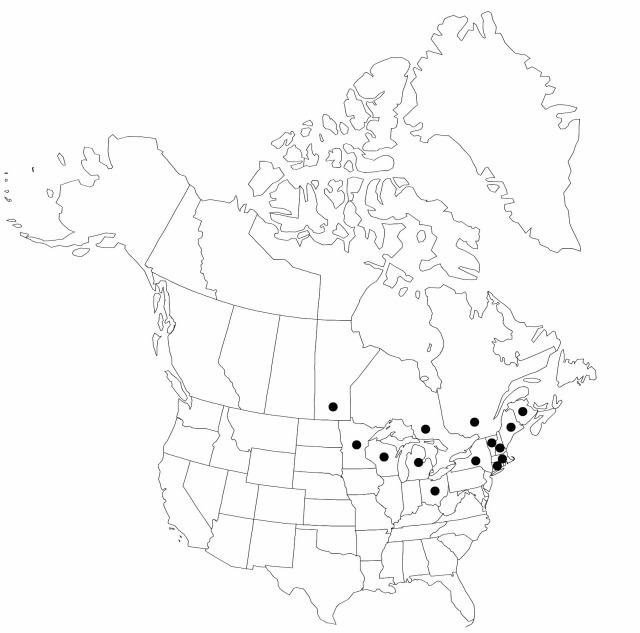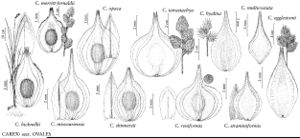Carex merritt-fernaldii
Bull. Torrey Bot. Club 49: 370. 1923.
Plants densely cespitose; rhizomes appearing elongate only in old clumps. Culms 30–100 cm; vegetative culms few, inconspicuous, with fewer than 15(–17) leaves, not strikingly 3-ranked. Leaves: sheaths adaxially white-hyaline, summits U-shaped to truncate, sometimes prolonged 1–2 mm beyond collar, not puckered, finely papillose; distal ligules 2.5–4.8 mm; blades 3–6 per fertile culm, 14–32 cm × 1.5–3 mm. Inflorescences compact to open, occasionally elongate and arching or nodding, reddish brown or straw colored, 1.5–5 cm × 7–15 mm; proximal internode 5–15 mm; 2d internode 3–7 mm; proximal bracts scalelike with bristle tips shorter than inflorescences. Spikes (4–)6–8(–10), distinct, ovoid, 7–15 × 5–9 mm, base rounded, apex rounded or nearly acute. Pistillate scales light yellow-brown with paler midvein, lance-subulate or lanceolate, occasionally broadly lanceolate, (3.2–)3.4–3.8(–4.2) mm, 0.2–1.3 mm shorter than perignyium beaks, narrower than perigynia, margins white-hyaline, 0.1–0.3 mm wide, apex acute. Anthers 1.3–2.6 mm. Perigynia 15–80 in larger spikes, ascending, light green to straw colored, conspicuously 5–9-veined abaxially, veinless or faintly 1–5-veined adaxially, broadly ovate to ovate-orbiculate, plano-convex, 3.3–5 × 2.3–3.5 mm, 0.5–0.8 mm thick, irregular, margin flat, including wing 0.4–0.8 mm wide, with 1–2 veins in yellowish wing, smooth; beak red-brown at tip, flat, 0.7–1.6(–1.8) mm, ciliate-serrulate, abaxial suture ± conspicuous, distance from beak tip to achene 1.8–3.1 mm. Achenes ovate or orbiculate, 1.4–1.8 × 1.1–1.5 mm, 0.5–0.7 mm thick. 2n = 70, 74.
Phenology: Fruiting early–mid summer.
Habitat: Dry sands, gravels, rocky places, meadows, roadsides, on acidic substrates
Elevation: 50–600 m
Distribution

Man., N.B., Ont., Que., Conn., Maine, Mass., Mich., Minn., N.H., N.Y., Ohio, Vt., Wis.
Discussion
Selected References
None.
